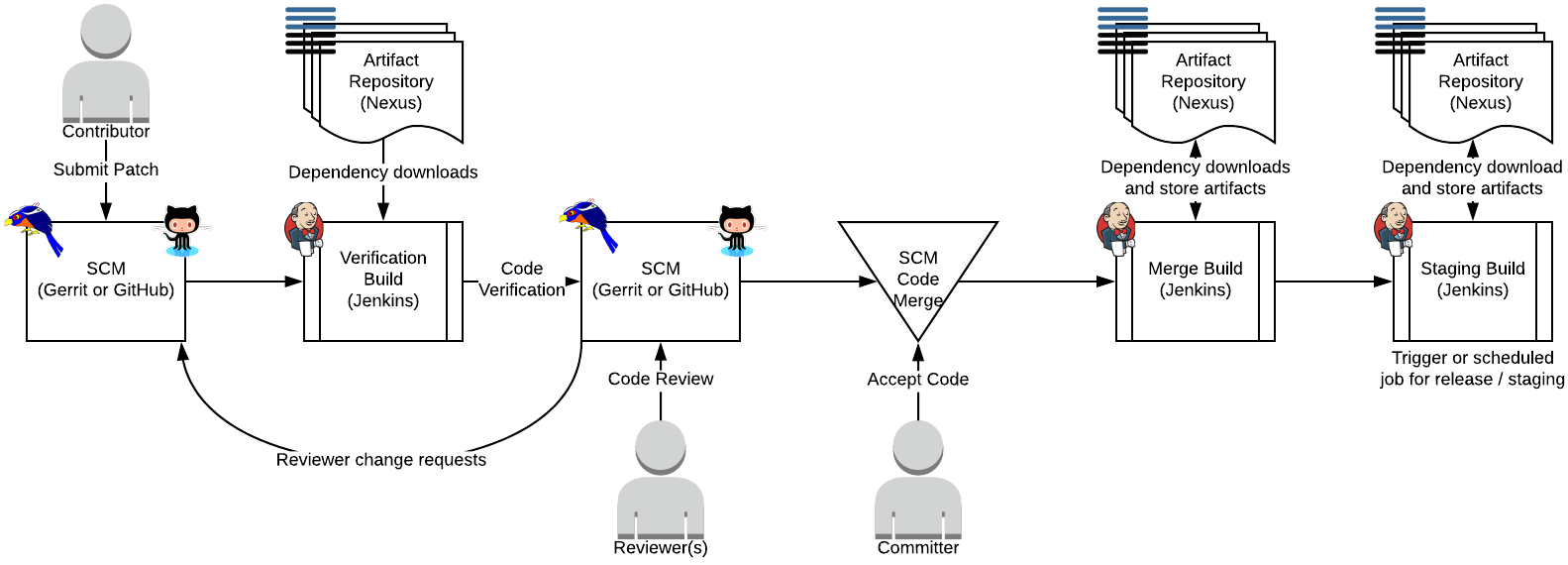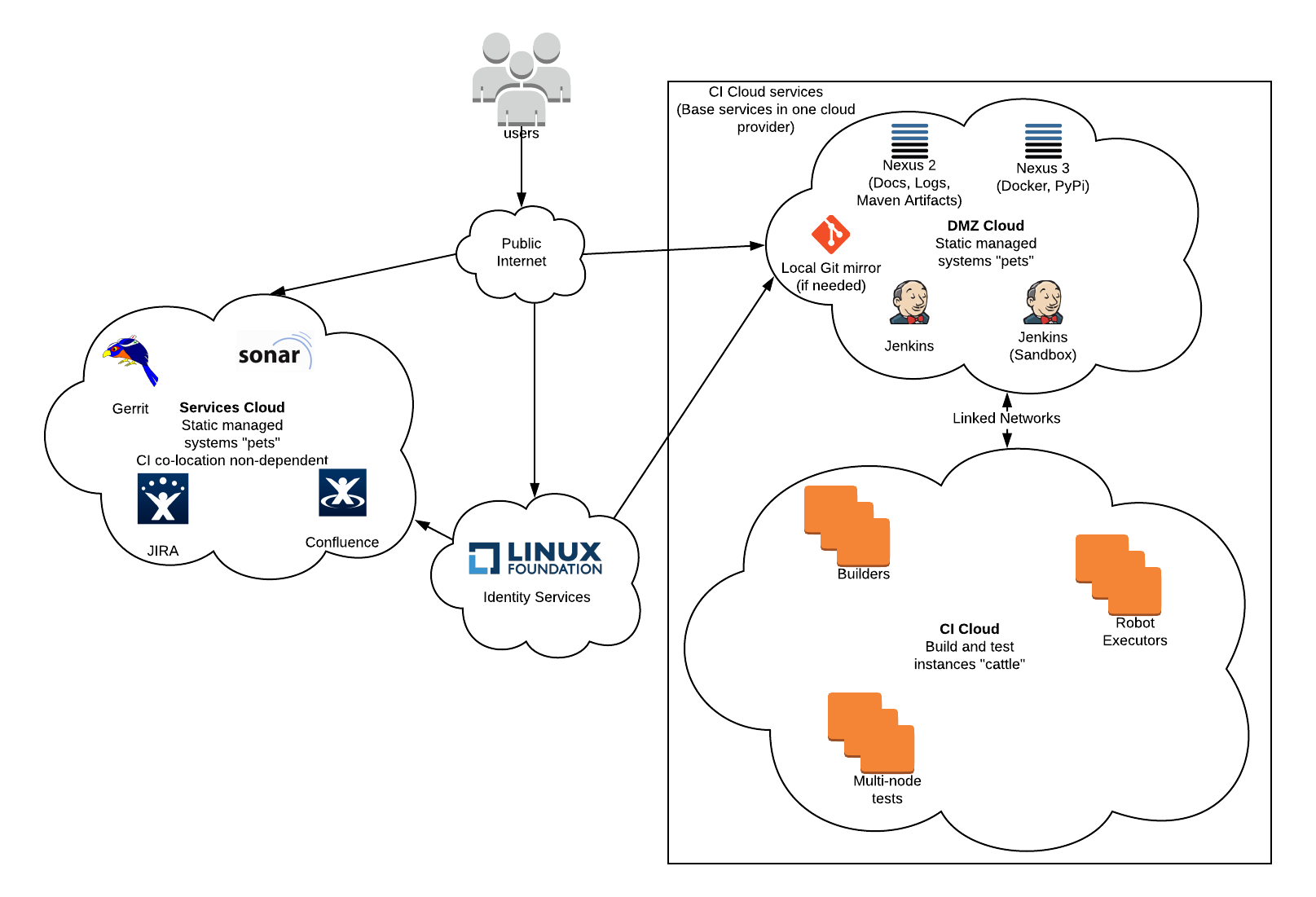Projects coming to The Linux Foundation (LF) for Continuous Integration (CI) services are generally given a similar infrastructure to the rest of our other projects unless there is a good reason to deviate from this configuration.
This infrastructure enables the developers to all have similar workflows which makes it possible for the communities to help each other out with how to work in the environment. The development workflow enabled is in Figure 1.
Figure 1
The standard infrastructure configuration that we build for projects is in Figure 2.
Figure 2
This design allows services to be logically separated and moved around to different cloud providers based upon the needs of the project as well as costs related to operating in given clouds.
The basic configuration puts our CI systems along with artifact storage into a special DMZ Cloud which is where communities interact with the CI infrastructure itself. This cloud is then linked to a private dynamic instance cloud that has the ability to access the DMZ resources and external internet services, but not anything deeper into the core LF networks.
Services that are not dependent on being co-located with the CI infrastructure will be in a different cloud. While this cloud, may be with the same provider, it may be a different provider. We do this to ensure that the CI build infrastructure itself has as little capability of potentially jail breaking / exploiting potential security issues in the code repository hosting in particular but also any other services hosted in the infrastructure.
Pre-formation
When services for a project are first being setup, the project will be in a pre-formation phase. During this phase most services allow a non-public, restricted set of people, access the resources.
Pre-formation participants will receive invitations to one or more access groups. These groups will have their name set in a way to show that they are for pre-formation access. While the group names will include the demarcation of gerrit, this is an artifact of our naming groups that power Gerrit access rights. CI (Jenkins), issue tracking (JIRA), wiki (Confluence) will have access granted via this same group.
Long term storage of CI logs is not complete during this phase as the log shipping mechanisms that we use for capturing the console logs require that the CI infrastructure be open to the public. To improve the log storage, as well as avoid potential issues with licensing for JIRA and Confluence the recommendation for projects is stay in pre-formation for as short a time as possible or if possible, skip a restricted formation phased altogether.
Preparation for code seeds
Code contributed to a project as seed needs to meet the following criteria:
The code must pass any required Intellectual Property Review (IPR) that is in use by the project
The code must pass any licensing requirements related to the licensing used by the project
The code contribution must be a squash commit. This means losing history. The reasoning for this is that The Linux Foundation requires that any projects that we host must conform to the Developer’s Certificate of Origin (DCO) indicated by a
Signed-off-bycommit message footer by the author of non-merge object commits in the code which indicates that they have read and agree to the DCO.
Developer’s Certificate of OriginDeveloper Certificate of Origin Version 1.1 Copyright (C) 2004, 2006 The Linux Foundation and its contributors. 1 Letterman Drive Suite D4700 San Francisco, CA, 94129 Everyone is permitted to copy and distribute verbatim copies of this license document, but changing it is not allowed. Developer's Certificate of Origin 1.1 By making a contribution to this project, I certify that: (a) The contribution was created in whole or in part by me and I have the right to submit it under the open source license indicated in the file; or (b) The contribution is based upon previous work that, to the best of my knowledge, is covered under an appropriate open source license and I have the right under that license to submit that work with modifications, whether created in whole or in part by me, under the same open source license (unless I am permitted to submit under a different license), as indicated in the file; or (c) The contribution was provided directly to me by some other person who certified (a), (b) or (c) and I have not modified it. (d) I understand and agree that this project and the contribution are public and that a record of the contribution (including all personal information I submit with it, including my sign-off) is maintained indefinitely and may be redistributed consistent with this project or the open source license(s) involved.Refer to https://developercertificate.org/ for the original text.
LF does not presently have, nor is it aware of, tooling that will allow us to properly scan incoming repository histories to verify that they meet this. Requiring a squash commit of seed code is the way that we can definitively enforce this.
Post-formation
Once a project exits the pre-formation phase the following will happen:
- Hosted services open to the public
- The services inventory will get updated with the standard public services

